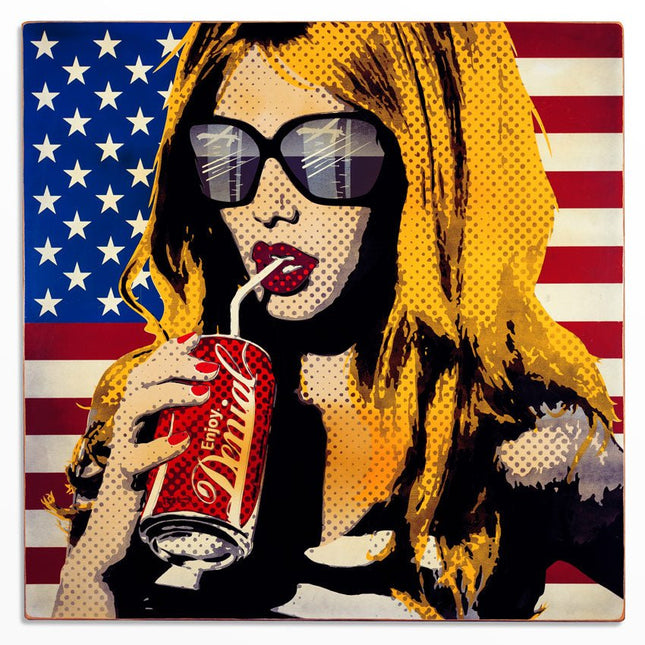The Intersection of Advertising, Brands, and Street Art
Advertising through street graffiti art is a controversial practice that has been debated for many years. On the one hand, it is a creative way to promote products and services unconventionally. On the other hand, others see it as a violation of public spaces and a form of visual pollution. One of the main concerns with advertising in street graffiti art is that it can be seen as a form of corporate co-optation of a grassroots movement. Graffiti art has historically been associated with political dissent, social commentary, and artistic expression. Some argue that using this medium to promote commercial interests undermines the authenticity and integrity of the art form.
Furthermore, advertising through street graffiti art can be seen as a violation of public spaces. The relationship between advertising, brands, and street art has evolved dramatically, with each element borrowing from and influencing the others. Street Pop Art & Graffiti Artwork, once seen as a form of rebellion against mainstream culture and commercialization, has now, in many instances, become a tool for that very commercial world it once stood against. This intersection has given rise to a fascinating dialogue within the art community about street art's role in advertising and the commodification of brands. Street artists have long appropriated logos, slogans, and other corporate branding elements to critique consumer culture and the pervasiveness of advertising in public spaces. This appropriation often involves subverting brand imagery or using it in ironic ways to challenge the messages conveyed by corporations. This form of artistic expression serves to reclaim public spaces from the clutches of corporate advertising and spark conversations about consumerism's impact on society.
Brands Embracing Street Art Aesthetics
Conversely, brands have increasingly sought to harness the authenticity and 'cool' factor associated with street art. By commissioning street artists to create murals or to design products, brands aim to tap into the youth market and align themselves with the values associated with street culture. This collaboration has brought street art into the mainstream and has provided street artists with new platforms to showcase their work. However, it has also raised questions about the commercialization of an art form that was traditionally anti-establishment and has prompted discussions about the balance between artistic integrity and commercial success. The collaboration between street artists and brands can lead to a symbiotic relationship where artists gain exposure and financial support. In contrast, brands benefit from the association with the cutting-edge and socially conscious image of street art. However, it can also lead to accusations of selling out and diluting the subversive power that street art can wield.
Advertising as Inspiration for Street Art
In pop art, the influence of advertising and branding has always been evident, with artists like Andy Warhol turning the imagery of consumer goods into high art. Street artists have continued this tradition, using the techniques and aesthetics of advertising in their work. This can involve mimicking the slick production values of commercial billboards or adopting the language of advertising to convey an anti-consumerist or anti-corporate message. Advertising and branding provide a rich source of material for street artists to critique, and in doing so, they mirror contemporary society's values and priorities. By co-opting brands' imagery, street artists can comment on issues ranging from globalization to environmental degradation, making their work relevant and accessible to a broad audience. Graffiti art is often created without permission from property owners or city authorities and can be seen as vandalism. This raises questions about the ethics of using public spaces to promote commercial interests, mainly if done without consent. Despite these concerns, there are some arguments in favor of advertising through street graffiti art. For one, it can be seen as a creative way to reach a young and urban audience. Street art is often seen as edgy and calm, and by using this medium to promote products and services, companies can tap into this cultural currency.
Moreover, advertising through street graffiti art can be seen as a way to support and encourage emerging artists. Companies can commission artists to create graffiti art that incorporates their products or branding, providing a platform for these artists to showcase their talents and gain exposure.
In conclusion, advertising through street graffiti art is a controversial practice that raises questions about the ethics of using public spaces to promote commercial interests. While there are arguments in favor of this approach, there are also concerns about its impact on the authenticity of the art form and the use of public spaces. Ultimately, it is up to individual companies to decide whether this strategy aligns with their values and goals.
Cultural Implications of Branding in Street Art
The use of branding in street art also has more profound cultural implications. It reflects the increasingly blurred lines between high and low cultures, art and commerce, and public space and advertising billboards. In a world where consumers are constantly bombarded with advertising messages, street art incorporating branding can either contribute to the visual noise or cut through it with a powerful message. For street artists, the challenge is to use the imagery of advertising to enhance their message rather than undermine it. For brands, the challenge is to engage with street art in a way that is respectful and understanding of its history and ethos. As street art grows in popularity and visibility, the relationship between advertising, brands, and street art will undoubtedly continue to evolve, raising new questions and sparking fresh debates within the art world.




